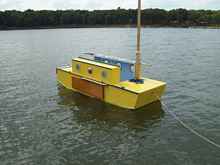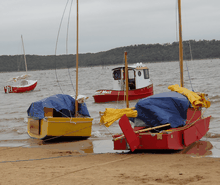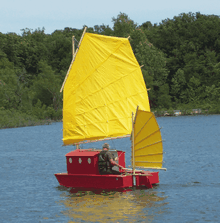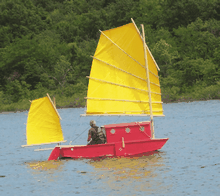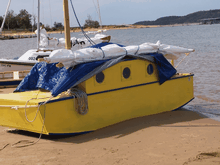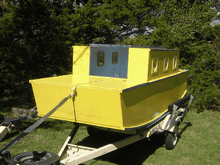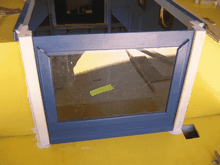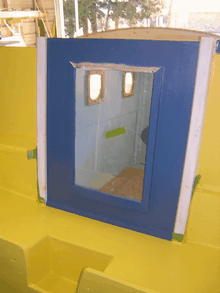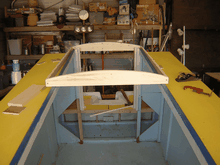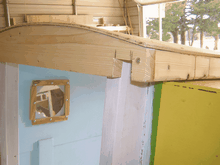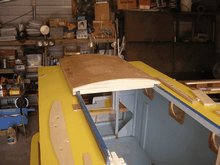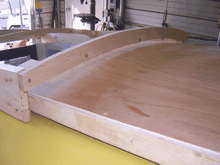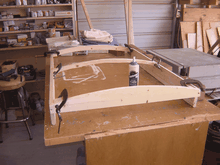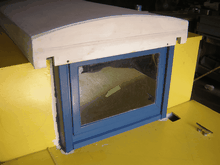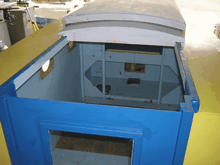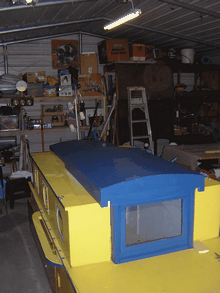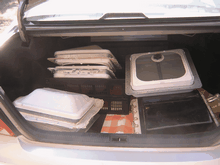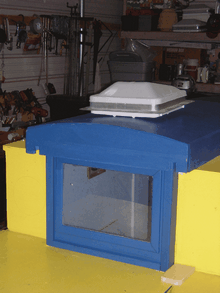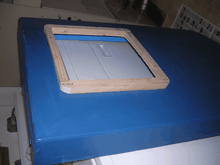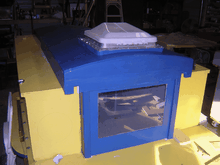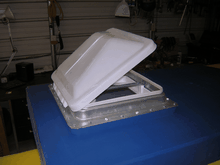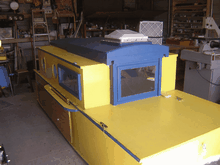
 Custom Search
|
| sails |
| plans |
| epoxy |
| rope/line |
| hardware |
| canoe/kayak |
| sailmaking |
| materials |
| models |
| media |
| tools |
| gear |
| join |
| home |
| indexes |
| classifieds |
| calendar |
| archives |
| about |
| links |
| Join Duckworks Get free newsletter CLICK HERE |
|
|
| Building Sliding Hatches/Doors |
by Bill Nolen
- Oklahoma City, Oklahoma - USA |
for a Yellow Puddle Goose!BACKGROUND:In early September 2012, I received an email from my friend Gene Berry asking me if I would like to have his Yellow Goose! Well, it took me less than a minute to fire off a return email stating that "YES! YES! I WANT THE YELLOW GOOSE"! Gene's Yellow Goose had been constructed a couple of years before with a large "Bird-Watcher" type cabin, and was a great sailboat. It had been voted "Most Colorful Boat" in 2011 at the Sail Oklahoma Boating Festival.
The only condition was Gene needed to use the Yellow Goose to camp and sleep in during the October 2012 week long Sail Oklahoma Boating Festival. Gene had built a new bright red cabin PDGoose, with a yellow junk sail, to sail during the 2012 Event. Gene had named the boat "Andy's Junk" in honor of Andrew Lynn, who had posted some drawings of a Junk rigged Goose on the PDGoose web site. Photos showing the Red Andy's Junk, and the Yellow Goose on the beach at the 2012 Sail Oklahoma Boating Festival.
During the 2012 Sail Oklahoma Boating Festival, the Yellow Goose was voted "Best Rectangular (Duck Like) Boat" at the Event. Without a doubt it's a great sailboat, and I was looking forward to towing it home as soon as possible. The weather during the 2012 Sail Oklahoma Festival was unusually cool. I had noticed that Gene Berry had placed a tarp over the Yellow Goose's bird watcher opening to provide some weather and wind protection the week he slept in the boat. Gene told me that he was quite comfortable in his sleeping bag! Gene's new Red Goose had a cabin with a sold top. However, Gene had loaned the use of the Red Goose's cabin to boat designer Jim Michalak, as Jim wanted to be on the beach, close to where the boating action was taking place. Photos showing the Yellow Goose covered with a tarp, and Jim Michalak snug in the Red Goose.
Once I had the Yellow Goose home in my yard I started thinking about modifications I could make to make the boat a bit more elderly friendly. One major change, with Gene's approval, was to make the boat into more of a Motor-Shanty than a Sailboat. The reason is that I'm at the age that there are times when using a out-board motor is easier on the old body than messing with a sailing rig! However, the story on how the Goose was modified to be a Motor-Micro-Shanty is the subject of another article, and will not be covered here. During the 2012 Sail Oklahoma Event, I had a brief discussion with Jim Michalak about using hard sliding hatches on boats with the bird-watcher cabin top openings or slots. As I remember, Jim's comments were to the effect that several builders had made hard top hatches for the top openings on their boats. However, most of the builders who had done so had returned to soft cloth type covering! Well, good advice has never deferred me from doing something I wanted to do. The more I thought about how nice it would be not to have to install a tarp or soft cover during a wind driven rain storm, the more I wanted to make hard sliding hatches and doors. It would be my winter building project! Already I could envision myself lying inside, snug and dry, in my soft bed while it rained outside! CONSTRUCTION:I first though about making three sliding hatches that would slide under/over each other. I soon discarded that idea because the third hatch would be sticking up too high if I made domed hatches. It might also greatly reduce my forward vision. I decided to make two sliding domed hatches with the taller hatch in front, sliding over the smaller back hatch. The two hatches could be slid under/over each other anywhere along the cabin top rails. Visually, the taller front hatch would look better placed at the rear. The problem in doing that is that the overlap of the two hatches should face the stern of the boat to reduce the amount of rain that could enter the overlap when trailering. To make the two sliding hatches I used some 5 mm plywood, and some 1 x 4-inch pine boards I had on hand from a previous project. Making curve or doomed tops for the hatches is quite a bit more work than flat topped hatches. So, of course, that is what I wanted to build! However, before I could make the sliding hatches I first had to make (door) hatches to close off the two-foot wide stern, and bow openings in the boat's open slot cabin, as shown in this photo. I wanted the top hatches to overlap the installed doors to keep the cabin nice and dry!
Using 1-inch by 4-inch boards I made a simple frame, with two side groves, for the door hatches to slide in and out from the top of the cabin opening. I then cut door panels from two scrap pieces of 5 mm plywood, marking where I wanted to place the Plexiglas windows.
After cutting the openings, making some crude window frames, and a bit of painting, I inserted the Plexiglas windows into the front and rear door hatches. I used a special 100% Silicon Plastic Sealant, made by GE, to seal around the Plexiglas windows.
After adding the top trim to both door hatches, I started making the first sliding hatch. To ensure that the larger hatch would fit over the smaller rear hatch I made the rear hatch first. Just 1 X 3-inch side boards, and 1 x-4- inch curved front and rear boards to make the frame, A curved center brace was added to ensure the curve of the 5 mm plywood top would bend properly.
After I had the rear-sliding hatch roughed out with the domed top glued in place, I started on the larger higher front sliding hatch. I used the same type of framing, only taller to slide over the rear hatch. This photo shows the partly built frame placed over the rear-sliding hatch to ensure it would fit properly.
I then added a curved top as shown in these photos. Placing the hatches over the slot opening ensured that they did indeed slide over and under each other.
Prior to making the two sliding hatches I had looked at dozens of different methods to provide a method for the hatches to be attached to the open cabin rails. There are many tried and workable methods to use, provided there is only one sliding hatch, and it is mounted to be permanently in place. I would have two sliding hatches, and I wanted to be able to quickly remove the hatches to store them in the cabin. So, after much pondering, I decided to take the easy way and just have the sliding hatches fit over the opening rails, and not slide in special groves, etc. When trailering, the hatches should be secured with straps over the tops, and perhaps catches on the inside.
After paint the hatches, I thought I was finished with the sliding hatches except with the catches for inside the Goose's cabin. However, I learned that a local RV dealer had several new and used RV Vents he wanted to get rid of! I ended up buying eight of the Vents for a very low price of $2.00 each!
How does this vent look? I think it might work well for some needed ventilation.
A 14-inch square cutout in the domed front hatch was all that was required. I made a simple framework to hold the RV vent level, and attached it with glue and brad. Some paint, and them some sealer and screws, and it was installed!
CONCLUSIONS:I believe the sliding hatches, doors, and RV Vent will serve me well this coming summer! However, after building the two sliding hatches, I must state that it is very doubtful that I would build any future hard sliding hatches for a sailboat with an open slot cabin top. The main problem is the weight of the hatches. The total weight for my two hatches is 27-pounds with the 3-pound RV Vent installed. Ten pounds for the smaller rear hatch, and 17 pounds for the front hatch. That's not a large problem for a motor powered Micro-Shanty. However, I'm not sure I would be comfortable in a sailboat, with that much extra weigh topside. A nice water-proof cloth cover for the cabin slot opening would be much easier to store in the cabin, and even with bows wouldn't weigh much more than a couple of pounds! I believe it would also be much easier and faster to make.
Fair winds to all and especially to Gene Berry - a good friend to everyone he meets.
|
|


